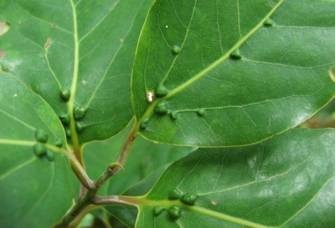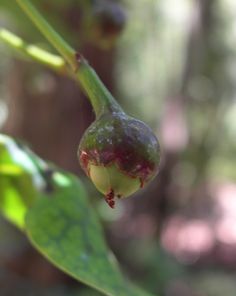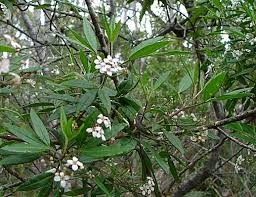Stinkwood – Ocotea bullata
(Stinkhout)
Stinkwood occurs from the Cape Peninsula to the Eastern Transvaal, but is absent in the Eastern Cape. It is a Protected Species, and is listed as Endangered in the South African Red List. Stinkwood is considered one of the most highly prized timbers in the world.
The Tree
It is a medium to large evergreen tree, and can grow up to 30m in height.
The bark is grey and mottled with white and orange circular patches, becoming rough and scaly. It has horizontal ridges and corky spots when young, but becomes flaky and dark grey-brown with age. The tree usually has a single stem, but sometimes shoots develop from the base of the stem or from an old stem, and these may grow into trees. The bark is greatly sought after for use in traditional medicine.

Flowers are male, female or hermaphrodite. The small, yellowish-green or creamy flowers are in loose clusters in the axils of the leaf stalks near the tips of the branches. December – February.
The fruit resembles an acorn. It is yellowish green to purple when ripe, with a large soft seed – about 20mm long. March – June.
Properties
The common name “stinkwood” is derived from the offensive smell of the freshly cut wood. The heartwood is light to dark brown and the sapwood is greyish to yellowish-brown, not easily distinguishable from the heartwood. The darker striping makes it a very attractive timber. After years of exposure, the wood turns dark brown to black. The wood has a fine texture, a straight to spiral or interlocked grain with a high lustre.
Woodworking Properties
This wood is moderately heavy, durable and stable. The wood saws easily, although the darker coloured wood is fairly difficult to process. In planing, the wood is inclined to rough-up in patches. However, scraping produces a good surface. The wood has good nailing properties. It glues and takes all finishes well. The sawdust is reported to be an irritant, causing sneezing.

This wood is suitable for high-value furniture, cabinetry, paneling, decorative items, carving and turnery. In the past it was used for wagon and boat building, railway sleepers, joinery and agricultural implements. George Rex’s brig, ‘Knysna’ was built almost entirely of Stinkwood.
Green weight: 1090 g/m3
Dry weight: 755 kg/m3
Source: Trees of the Garden Route / Elna Venter
Southern African Wood / Stephanie Dyer, Barry James & Danielle James
If you are looking to buy wood, please click here to visit our Timber slab sales page.


